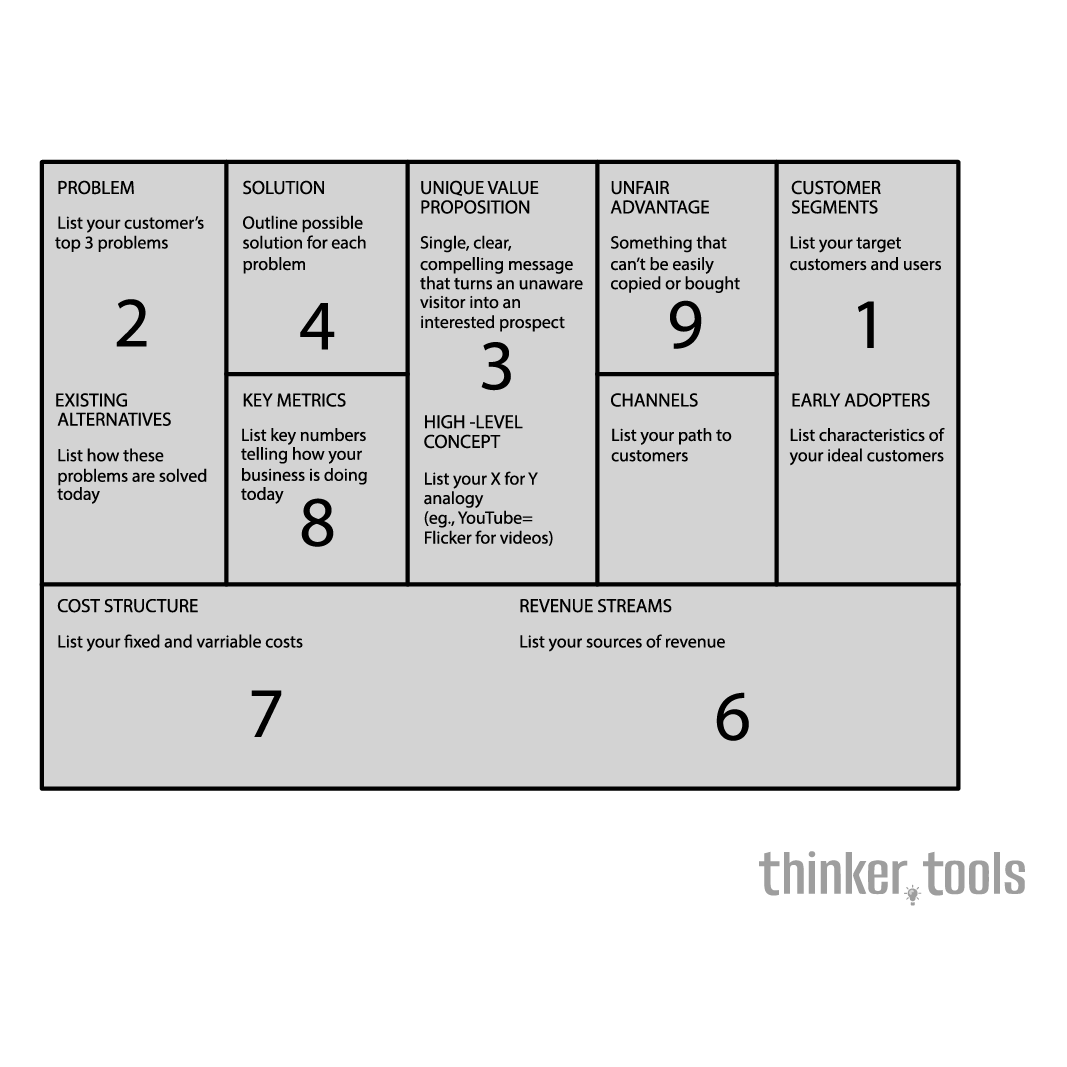
What is the Lean Canvas?
The Lean Canvas is a strategic management template for developing new or documenting existing business models. It's a visual chart with nine building blocks that help entrepreneurs map out the most important aspects of their business quickly and see how they relate to each other. Unlike traditional business plans that can take weeks to write and quickly become outdated, the Lean Canvas can be completed in minutes and easily updated as you learn.
History and Origin
Created by Ash Maurya in 2010, the Lean Canvas was adapted from Alexander Osterwalder's Business Model Canvas. Maurya, an entrepreneur and author of "Running Lean," recognized that the original Business Model Canvas, while excellent for established businesses, didn't quite fit the needs of startups operating under extreme uncertainty. He modified several sections to better align with the Lean Startup methodology pioneered by Eric Ries, creating a tool specifically optimized for entrepreneurs.
How to Use the Lean Canvas: Step by Step
Step 1: Start with the Problem
Begin by identifying the top 1-3 problems your target customers face. Be specific and focus on problems worth solving. Also, list existing alternatives—how are people currently solving these problems?
Step 2: Define Customer Segments
Identify your target customers and users. Be as specific as possible. Who experiences the problem most acutely? Consider creating separate canvases for distinctly different customer segments. Don't forget to identify your early adopters—the subset of customers most likely to buy first.
Step 3: Craft Your Unique Value Proposition
Write a clear, compelling message that states why you are different and worth paying attention to. This should be the intersection of what customers want and what you uniquely provide.
Step 4: Outline Your Solution
For each problem, outline a possible solution. Keep these solution boxes simple—avoid getting into feature details at this stage. Remember, your solution will likely evolve as you learn more about your customers.
Step 5: Identify Key Metrics
List the key numbers that tell you how your business is doing. Focus on actionable metrics rather than vanity metrics. What behaviors do you want to track that indicate progress toward your goals?
Step 6: Map Out Channels
List your path to customers. How will you reach them? Consider both inbound and outbound channels. Think about the entire customer lifecycle: awareness, evaluation, purchase, delivery, and after-sales.
Step 7: Determine Revenue Streams
Identify your revenue model, pricing, and lifetime value. How will you make money? What will you charge? Consider different pricing models and their implications for your business.
Step 8: Calculate Cost Structure
List your fixed and variable costs. What are the most significant costs in your business model? Consider customer acquisition costs, distribution costs, hosting, and people costs.
Step 9: Define Your Unfair Advantage
This is something that cannot be easily copied or bought by competitors. It could be insider information, personal authority, dream team, existing customers, or community. This box often starts empty—that's okay.
Practical Examples
Food Delivery App Example:
- Problem: People want healthy meals but lack time to cook
- Customer Segments: Busy professionals aged 25-40 in urban areas
- Value Proposition: "Healthy, chef-prepared meals delivered in 30 minutes"
- Solution: Mobile app connecting customers with local healthy restaurants
- Revenue Streams: Delivery fees + commission from restaurants
- Key Metrics: Orders per day, customer retention rate, average order value
Online Learning Platform Example:
- Problem: Professionals need to upskill but can't attend traditional classes
- Customer Segments: Working professionals seeking career advancement
- Value Proposition: "Learn in-demand skills from industry experts on your schedule"
- Solution: Bite-sized video courses with practical projects
- Revenue Streams: Monthly subscriptions + premium course fees
- Key Metrics: Course completion rates, monthly active users, churn rate
Benefits and Life Improvements
The Lean Canvas framework offers transformative benefits for entrepreneurs and innovators:
Speed and Agility: Complete a business model in 20 minutes instead of writing a 40-page business plan. This speed allows for rapid iteration and pivoting based on customer feedback.
Focus on What Matters: By constraining your business model to one page, you're forced to distill your idea to its essence, focusing only on what truly matters.
Risk Mitigation: The framework helps identify the riskiest parts of your business model early, allowing you to test assumptions before investing significant time and money.
Better Communication: The visual format makes it easy to share and discuss your business model with team members, advisors, and potential investors. Everyone can literally be on the same page.
Continuous Learning: The Lean Canvas is designed to be updated frequently as you learn from customers, making it a living document that evolves with your understanding.
Personal Applications: Beyond business, individuals can use the Lean Canvas format to plan career transitions, side projects, or even major life decisions by adapting the boxes to fit personal goals.
The Lean Canvas democratizes business planning by making it accessible to anyone with an idea. It shifts the focus from elaborate planning to rapid experimentation and learning. Whether you're launching a tech startup, opening a local business, or exploring a new project, the Lean Canvas provides a structured yet flexible framework for turning ideas into reality. By embracing this tool, entrepreneurs can move faster, reduce waste, and increase their chances of building something people actually want.